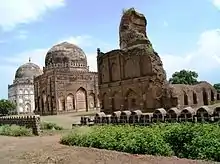Bahmani Tombs
The Bahmani tombs at Bidar are the tombs of the Bahmani dynasty.[1]
| Bahmani tombs | |
|---|---|
 The Bahmani tombs; The partially collapsed tomb of Humayun Shah is seen in the foreground | |
| Type | necropolis |
| Location | Bidar, Karnataka |
| Coordinates | 17.915°N 77.561°E |
| Built | 15th and 16th century |
| Architectural style(s) | Indo-Islamic architecture |
The Bahmani tombs are often confused with the Barid Shahi tombs, but while the former lies 4 km West of the town center at a place called Ashtur,[2] the latter lies within the town.
History
The tombs were erected from 1436 to 1535.[3]
Architecture
There are eight tombs of the Bahmani rulers.[2] The inscriptions of the tomb reveal the name of the king, his date of accession, and date of death. Persian poetry and Quranic verses are also inscribed.
Tomb of Ahmed Shah
The interior tomb of Ahmed Shah is decorated with frescoes.[4]
Tomb of Humayun Shah
The larger part tomb of Humayun Shah was destroyed by lightning.[5]
Tomb of Sultan Kalim-ullah
The Sultan Kalim-ullah was the last Bahmani ruler, a puppet monarch under the control of his prime minister Amir Barid.[6] The tomb was built after his death in 1527.
Tomb of Shah Rukh Khan
The tomb of Shah Rukh Khan is located to the North of Mahmud Shah's tomb. Historians believe he was a scion of the Bahmani dynasty, as only royal family members are buried here.[7] The Ayat Al-Kursi is inscribed over the eastern doorway.[7]
References
Citations
- The Cambridge History of India Vol. III: Turks and Afghans. Cambridge University Press. 1925. p. 635.
- Yazdani, 1947, pp. 114.
- Centre, UNESCO World Heritage. "Monuments and Forts of the Deccan Sultanate". UNESCO World Heritage Centre. Retrieved 3 October 2019.
- Yazdani, 1947, pp. 114-118.
- Yazdani, 1947, pp. 132.
- Yazdani, 1947, pp. 138.
- Yazdani, 1947, pp. 139.
- Yazdani, 1947, pp. 141.
Bibliography
- Yazdani, Ghulam (1947). Bidar, Its History and Monuments.
.jpg.webp)